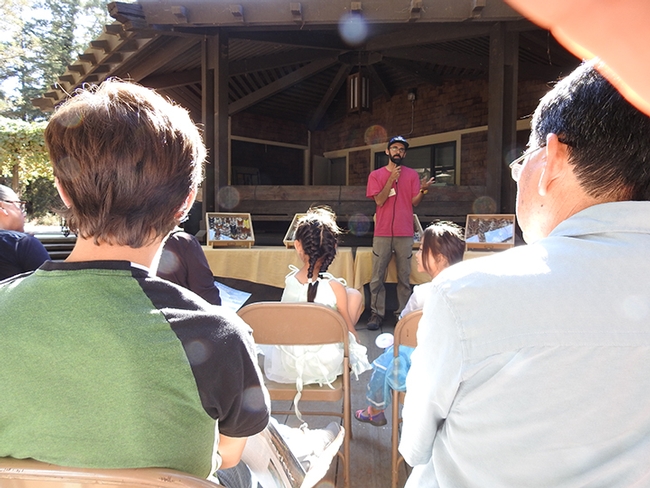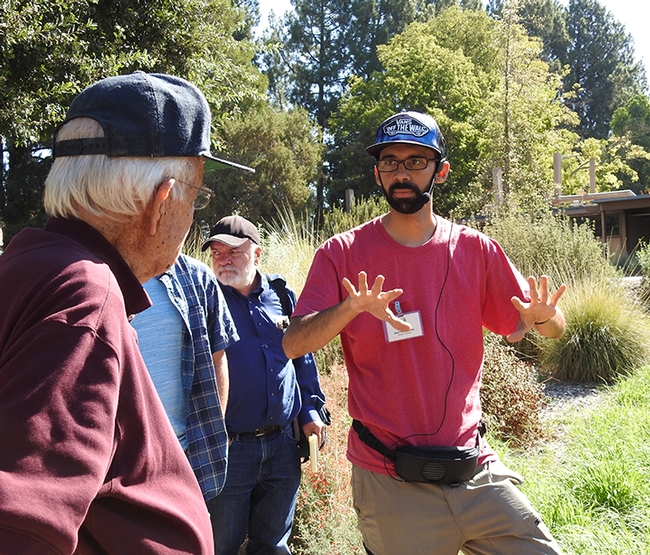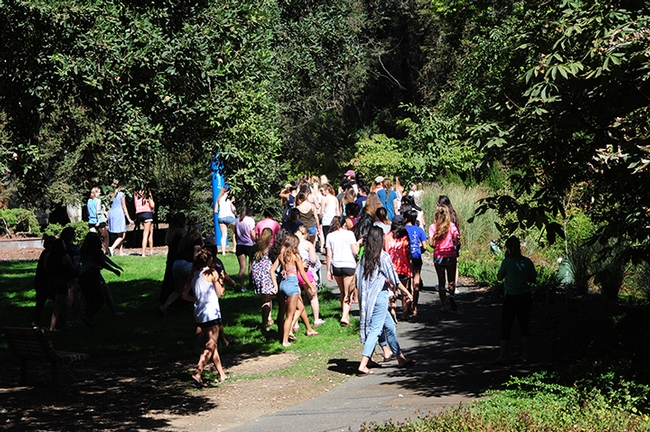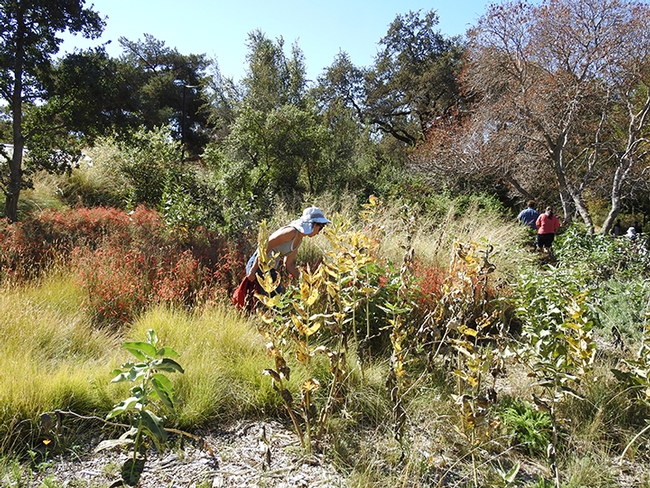- Author: Kathy Keatley Garvey
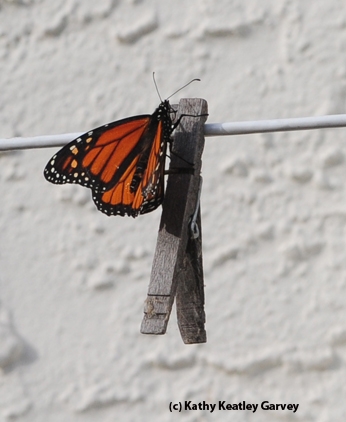
In the Pacific Northwest, they're heading for coastal California, including Santa Cruz and Pacific Grove, for their overwintering spots.
A few are tagged. Washington State University entomologist David James and his citizen scientists have tagged some with "monarch@wsu.edu" with a serial number. Look for them! Better yet, photograph them. And then contact him.
We've seen one WSU-tagged monarch in Vacaville so far (he was tagged and released by citizen scientist Steve Johnson on Aug. 28 in Ashland, Ore. and fluttered into our pollinator garden on Sept. 5), but many more butterflies are migrating through.
One of the monarchs in James' program was photographed on a San Francisco rooftop on Sept. 18 and seen again Oct. 11 in an overwintering colony in Santa Cruz. It was tagged and released by Molly Monroe and her 5-year-old daughter, Amelia, on Aug. 30 in Corvallis, Ore. Oregon Live did a piece on this.
James says this may give hope that the Steve Johnson progeny/Vacaville surprise "may well be found in one of the overwintering colonies this winter!" The entomologist and his family will be searching for tags in overwintering colonies from Santa Barbara to Bolinas from Nov 19-26.
Check out the "Monarch Butterflies in the Pacific Northwest" Facebook page for more amazing stories.
Meanwhile, migrating monarchs continue to make pit stops for flight fuel in our yard. Some look weathered and torn, no thanks to the inclement weather and cunning predators. Some look as if they're on their last legs...er...wings. They all look hungry. Nectar! Nectar! We need nectar!
We spotted a male nectaring on a Mexican sunflower (Tithonia) and minutes later, a female touched down on the same flower. The scene reminded us of an exquisite painting. Autumn's reigning colors gracing a one-of-a-kind canvas.
Then came the wonder of wonders: a monarch headed for the clothesline and snuggled up to a clothespin.
Let's hope that wasn't the bottom line...
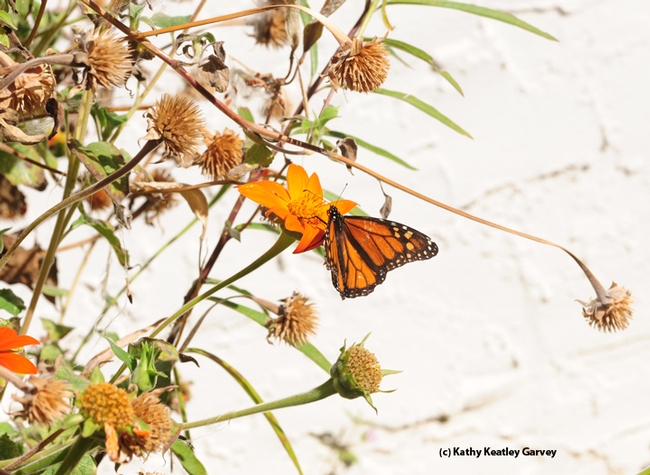
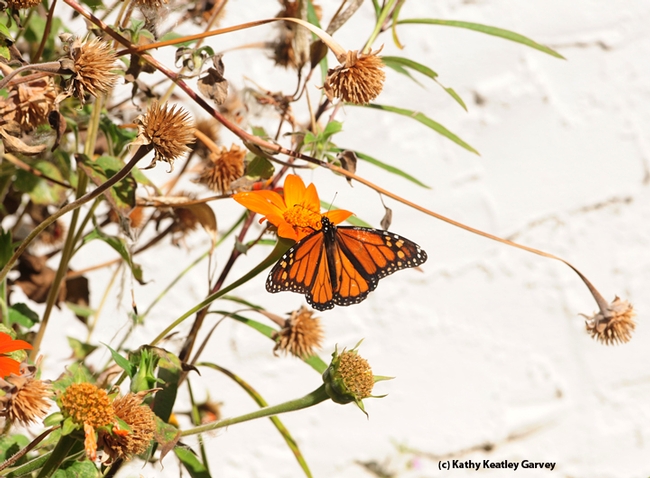
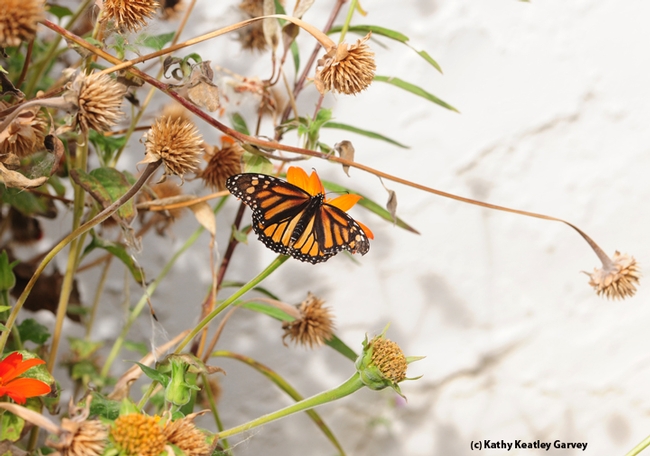
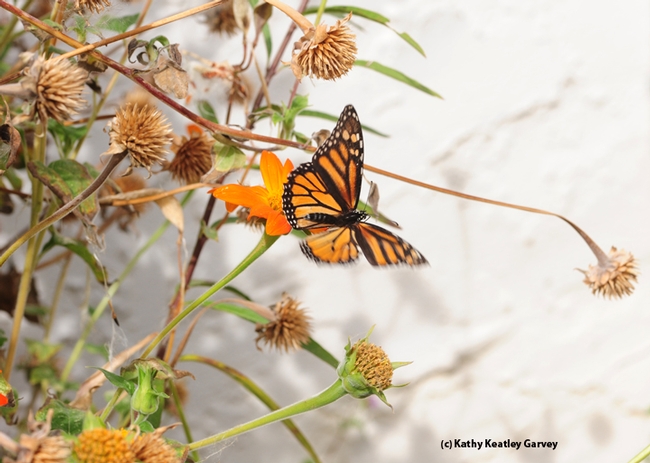
- Author: Kathy Keatley Garvey
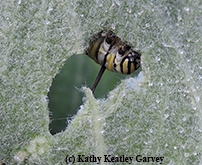
Monarch butterflies are migrating now, but we're still finding a few caterpillars in our pollinator garden in Vacaville, Calif.
We recently plucked off five caterpillars from our milkweed plants (our game plan is protect them from California scrub jays and other birds, tachinid flies, wasps and the protozoan parasite, Ophryocystis elektroscirrha or OE, for short).
These are the last 'cats of the season.
Ours is a small-scale conservation project. Our goal is to reach 50 by the end of the season. We're on track to do our small part for the declining monarch population. Plant milkweed (the host plant of monarchs), plant nectar-rich flowers such as Mexican sunflower (Tithonia), butterfly bush (Buddleia) and Lantana, and Danaus plexippus will come.
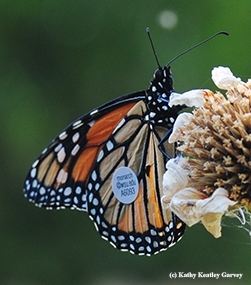
https://news.wsu.edu/2016/10/03/southbound-stopover-monarch-butterfly-big-surprise/
Weiford works inside the French Administration Building, named for former president C. Clement French. When I joined the Daily Evergreen news staff--way back when!--I used to interview Dr. French.
Small world.
And it became even smaller when the WSU-tagged monarch (monarch@wsu.edu), part of WSU entomologist David James' research program, stopped by for a visit. It was reared by citizen scientist Steve Johnson of Ashland, and tagged and released on Sunday, Aug. 28. "So, assuming it didn't travel much on the day you saw it, it flew 285 miles in 7 days or about 40.7 miles per day," James said. "Pretty amazing."
Yes, pretty amazing, indeed.
Now, with any luck--well, lots of luck--Steve Johnson's progeny has made its way to an overwintering colony in Santa Cruz or Pacific Grove.
And with any more luck, we'll be adding five more to the overwintering site.


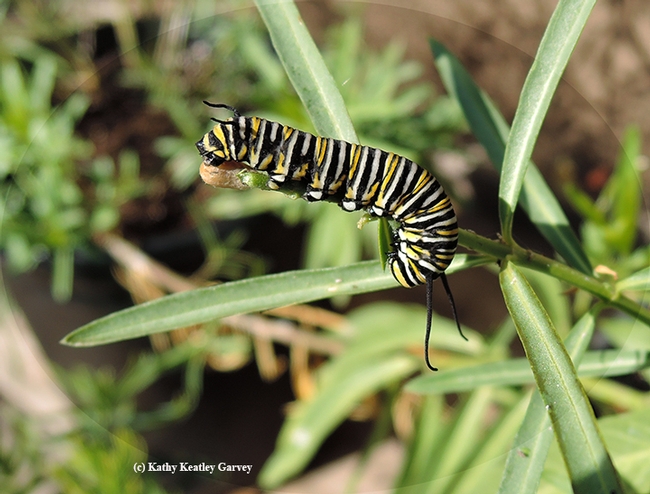
- Author: Kathy Keatley Garvey

When we drove to Santa Cruz on Dec. 27, 2014 to an overwintering site, we saw a monarch cluster 80 feet up--80 feet up, up and away--in a eucalyptus tree. We never saw a single tag. Then on Nov. 30, 2015 we drove to the Berkeley Aquatic Park to see a monarch cluster, 25 feet high in an ash tree. We never saw a single tag.
So it was really amazing, as recounted in a previous Bug Squad blog, to find and photograph a tagged monarch in our own backyard. The male monarch, tagged monarch@wsu.edu, A6093 and part of entomologist David James' research program at Washington State University, fluttered into our yard in Vacaville, Calif. on Monday, Sept. 5.
We later learned that citizen-scientist Steve Johnson of Ashland, Ore., a member of the Southern Oregon Monarchs Advocates, tagged and released the male monarch on Sunday, Aug. 28. So, the monarch flew 285 miles in seven days or about 40.7 miles per day, James pointed out. And it's one of his earliest recoveries.
But back to sightings of tagged migrating monarchs.
We asked butterfly guru, Art Shapiro, UC Davis distinguished professor of evolution and ecology, how many tagged migrating butterflies he's seen. He's studied the Central California population of butterflies—not just monarchs—for more than four decades, and is out in the field at least 200 days a year. A fellow of the American Association for the Advancement of Science, the Royal Entomological Society and the California Academy of Sciences, Shapiro maintains a website on butterflies at http://butterfly.ucdavis.edu/, where he records the population trends he monitors in Central California. He wrote A Field Guide to Butterflies of the San Francisco Bay and Sacramento Valley Regions, illustrated by artist Tim Manolis and published in 2007 by the University of California Press.
So, how many tagged monarchs has Art Shapiro seen in the field? "I've only seen one tagged one in the past decade--at Gates Canyon (Vacaville)," he said, "but it was too far away to read the tag, alas."
Curious, we asked a few other UC Davis scientists who study monarchs how many they have seen.
- Hugh Dingle, emeritus professor of entomology, none.
- Louie Yang, associate professor of entomology, none.
- Greg Kareofelas, an associate of the Bohart Museum of Entomology, two.
Karefoelas spotted his first tagged monarch on Table Mountain, Butte County “but it was a long time ago," he said. "It was long before I had a digital camera, so no pic."
Kareofelas sighted another tagged monarch at Knights Landing, Yolo County, on April 23, 1997. He found it on his father's ranch on Road 102, just south of Knights Landing. It was a male monarch, with the serial number #58984, tagged Jan. 29, 1997 at an overwintering site in Santa Barbara.
Kareofelas notified research project leader Walter Sakai, a biology professor at Santa Monica College, who thanked him for the find. Where exactly was it tagged? At Santa Barbara's Ellwood Main, located just west of the UC Santa Barbara campus in Goleta. In a letter to Kareofelas, Sakai wrote: “This is the furthest distance a tagged migrating monarch has traveled from our 1996-97 tagging effort. The second furthest was to Groveland near Yosemite. This recovery will be one piece of the puzzle in understanding the spring migration phenomenon of monarch butterflies."
Meanwhile, the Pacific Northwest monarch migration to coastal California continues through the end of October. Keep a lookout for a WSU-tagged monarch. If you find one (and be sure to photograph it, if you can) contact James at monarch@wsu.edu.
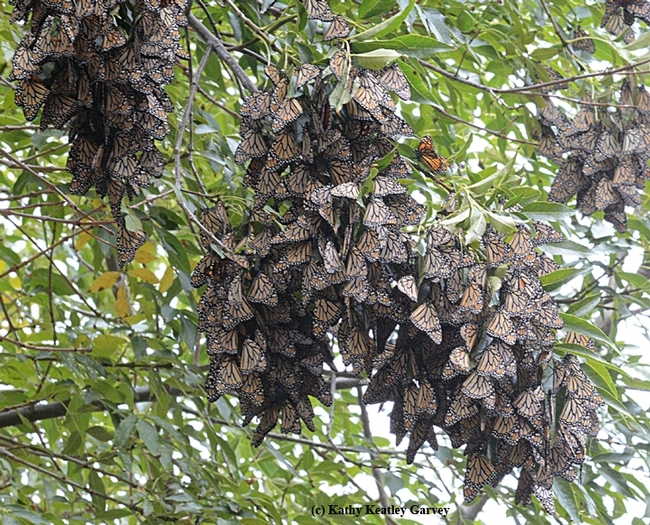
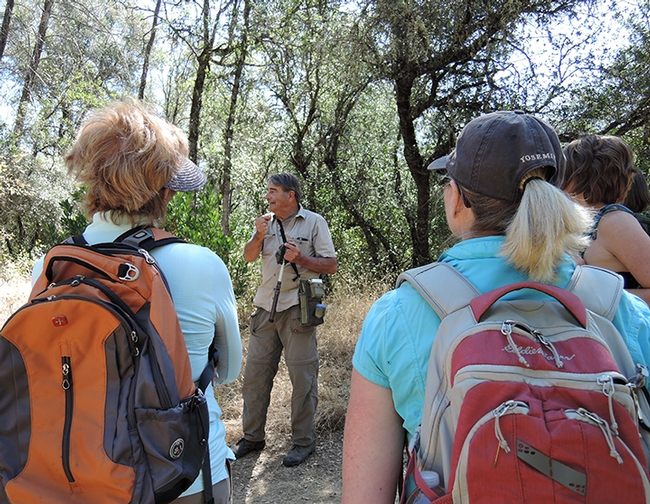
- Author: Kathy Keatley Garvey
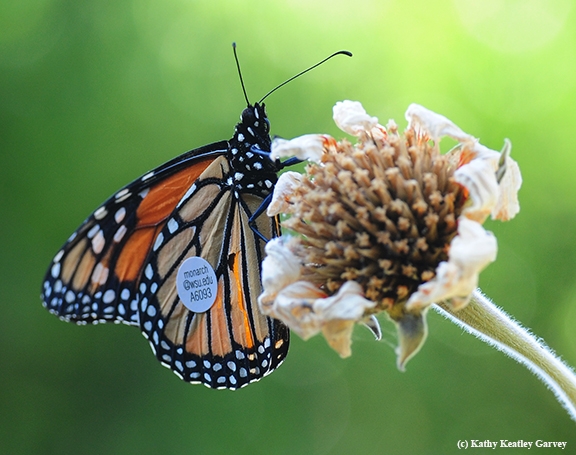
But at least we know he hails from Ashland.
That's what we learned about the male monarch that fluttered into our pollinator garden in Vacaville, Calif. on Monday, Sept. 5 (Labor Day) on his way to an overwintering site along the California coast.
The tag read "monarch@wsu.edu," and serial number "A6093," which ties the butterfly to a research project led by Washington State University entomologist David James. He maintains a network of Pacific Northwest citizen scientists who rear, tag and release monarchs.
When I wrote a Bug Squad blog on Oct. 17, 2014 about James' work, encouraging folks to be on the lookout for WSU-tagged monarchs, I figured I'd never see one. Not me. Not ever. And then it happened. A6093 dropped down for some flight fuel.
His presence was pure serendipity for several reasons: (1) I had earlier written about James' work; (2) I'm a WSU grad--"Go Cougars!" and (3) I rear monarchs for conservation purposes (40 so far this season).
So, on Labor Day, I happened to be hanging out in our 600-square-foot pollinator garden, the ever-present camera strapped around my neck, when I spotted a white-tagged monarch 15 feet away. I edged closer (three feet and 10 inches, to be exact), and photographed serendipity.

It was a good day to hang out with a marvelous, magnificent monarch linked to my alma mater and an insect that matters. And I did.
The fellow that reared him was Steve Johnson of Ashland, Ore., a member of the Southern Oregon Monarchs Advocates (SOMA). He tagged him and released him on Sunday, Aug. 28. "So, assuming it didn't travel much on the day you saw it, it flew 285 miles in 7 days or about 40.7 miles per day," WSU entomologist David James told me on Sept. 6. "Pretty amazing. So, I doubt he broke his journey for much more than the five hours you watched him--he could be 100 miles further south by now. Clearly, this male is on his way to an overwintering colony and it's possible we may sight him again during the winter in Santa Cruz or Pacific Grove!”
What a traveler! Let's see, by car it's 410 miles from Ashland to the overwintering site of Santa Cruz. It's 451 miles from Ashland to Pacific Grove. And it's about 113 miles from Vacaville to Santa Cruz. I can get lost in a five-mile range.
After posting a Bug Squad blog on the migrating monarch, I received a delightful email from Steve Johnson, with the subject line “I am the tagger!”
Omigosh! The tagger!
“I am so glad that my progeny, A6093, made it to Vacaville,” he began. “I have released about 80 monarchs thus far this season and have tagged about 30." This is his first year to tag. Some were raised from eggs while others were collected as caterpillars from native milkweed on a five-acre parcel outside of Ashland (a parcel that includes 2.5 acres of vineyards). Some were reared at his home in Ashland.

"Since that time, the population has exploded on the property. That fall, we found a large caterpillar in the vineyard and just put a fire pit screen over it to protect it. Well, it made its chrysalis on the screen and we moved it to our greenhouse since it was starting to get cool in October. After 21 days it eclosed and we released it at the very end of October. We seriously considered driving it to Redding because of the pending forecast for an early winter-type storm!”
Yes, "monarch parents" are dedicated!
So last year Steve and Laurel began collecting caterpillars from the five acres and rearing them in commercially available cages. And, with the seed they collected in her vineyards and gardens, they also planted showy milkweed (Asclepias speciosa) in large pots at his house in town. They released 85 monarchs last year.
This spring, he and Laurel planted more seed at his house in town, both in pots and in the ground. The old adage, "plant it and they will come," rang true. The monarchs came!
“Although the butterflies were not numerous, a few females loved to lay their eggs in the potted milkweed and we probably collected as many caterpillars/eggs on the 1/3 acre in town as we did on the five acres in the vineyard," Johnson related. "For some reason there are far fewer butterflies and caterpillars on the five acres this year as compared to last year. In fact, right now, we are only seeing occasional migrants nectaring on our butterfly wall. We had days where we would see 8-10 monarchs skittering about the vineyard and gardens but not close to what we had last year. In town, in addition, we planted heartleaf milkweed (Asclepias cordifolia) and despite its small size in the first year we collected a few caterpillars from this beautiful species.”
Give a lot of credit to the Southern Oregon Monarchs Advocates (SOMA), formed in 2014, and to its leader Tom Landis. Last year SOMA reared and released more than 2000 monarchs as part of the WSU project. "This year we're putting more emphasis on controlled rearing in schools and have over a half-dozen schools in northern California and southern Oregon participating," said Landis, who worked at a Forest Service nursery in Colorado and then served as an Extension agent for nurseries across the west. "My primary focus has been monarchs and milkweeds workshops (67 so far) and creating pollinator habitat with monarch way stations."
Meanwhile, WSU entomologist David James continues his monarch research. In his "Annual Project Progress Report for 2015: Developing an Understanding of Monarch Butterfly Breeding and Migration Biology in the Pacific Northwest," the associate professor wrote that "with assistance from inmates at the Washington State Penitentiary, a total of 1487 monarchs were reared, tagged and released from Walla Walla, Yakima and Prosser during August and September. An additional 1400 monarchs were reared and tagged by citizen science collaborators in Oregon, Idaho and Nevada. Nineteen fall migrants were tagged at Lower Crab Creek. Thus, a grand total of 2906 monarchs were tagged during late summer and fall 2015 in the Pacific Northwest. At the time of writing (February 2016), 16 tagged monarchs have been recovered at distances greater than 50 miles from the release location, mostly in overwintering colonies on the California coast. The longest distance traveled was 775 miles by 2 males released at Walla Walla and Pasco found in the same overwintering colony at Morro Bay, CA. "
His project goals and objectives are five-fold:
- To determine the phenology and ecology of monarch butterfly breeding in eastern Washington.
- To determine migration directions, routes and destinations used by summer and autumn monarch butterfly generations in the Pacific Northwest.
- To determine the environmental cues responsible for inducing reproductive dormancy and migratory behavior in Pacific Northwest monarch butterflies.
- To engage incarcerated citizens at the Washington State Penitentiary in scientific research with demonstrable social and educational benefits to themselves and the corrections community.
- To provide scientific information needed for development of effective and targeted nectar and host plant conservation strategies along monarch butterfly migration corridors
As for Steve Johnson, it's really a small world. The "Monarch Dad" is connected to UC Davis and the UC Agriculture and Natural Resources (UC ANR). His late father, Walter Johnson, a UC Davis grad, served as a UC Extension agent for 40 plus years in Alameda, Placer and Shasta counties. A brother and two nephews are also UC Davis grads.
As for A6093, we're all wondering where he is now. Johnson quipped that maybe the monarch needs a name instead of a number. Maybe the name of a vineyard? It's possible A6093 came from an egg or a caterpillar in a vineyard that Banke leased to Eliana Wines. "The owner has a small tasting room on the property (on Gaerky Creek Road) where the tasters can sit out and watch the monarchs," Johnson noted. The owner, determined to evoke the elegance of the wine, named his wine Eliana, which in Hebrew and Romance languages means "God has answered."
This is for certain: A6093 was born in Ashland: either in town or in a vineyard just outside of town. He was tagged and released from town.
Meanwhile, keep an eye open for WSU-tagged monarchs. Their migration will continue through Northern California to coastal California until the end of October, James said. Then in February, the monarchs will leave their overwintering sites and head inland.
Let's hope that A6093 or Eliana will be one of them.
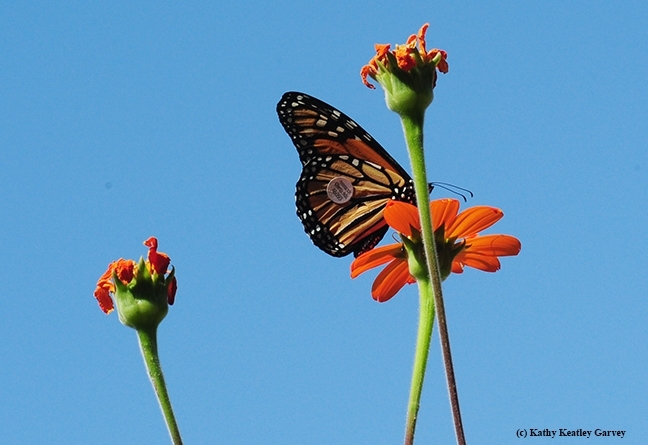
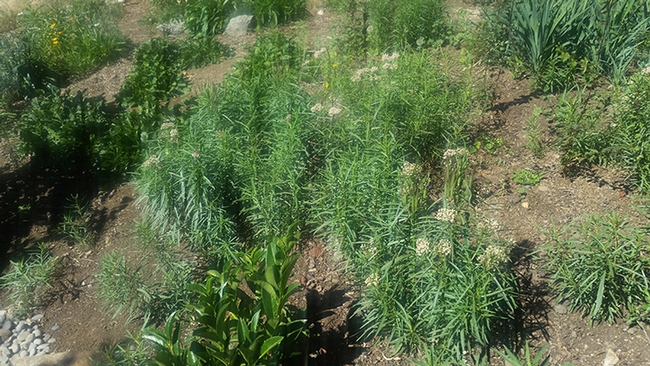
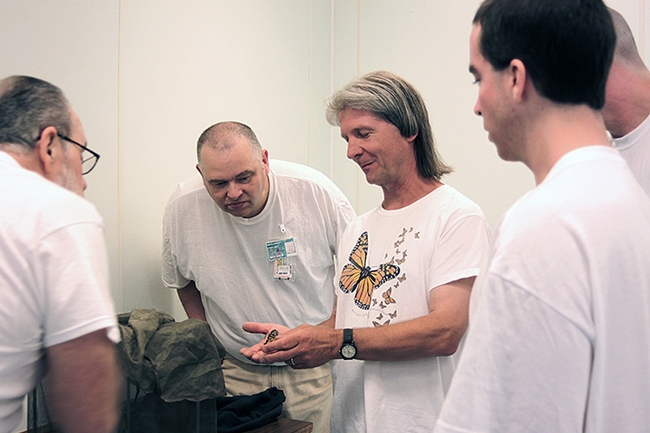
- Author: Kathy Keatley Garvey

Nearly 90 butterfly enthusiasts--from senior citizens to pre-schoolers--met up with entomologist Joel Hernandez last Sunday for his second annual talk and tour on "Butterflies Up Close," sponsored by the UC Davis Arboretum.
Hernandez, who has collected and curated insects for 19 years, told of his passion for Lepidoptera, the order of insects that includes butterflies and moths. "What draws me to butterflies," he said, "is the plethora of different colors and patterns that they display on their wings, as well as their life cycle.”
A 2014 graduate of UC Davis with a bachelor of science degree in entomology, Hernandez currently works for chemical ecologist Steve Seybold as a research/field assistant, and plans to enroll in graduate school.

Hernandez displayed butterfly and moth specimens from his California and Belize collections. His favorite butterfly? The blue morpho, Morpho peleides, a tropical butterfly with wings spanning five to eight inches.
As the tour members left the Wyatt Deck, walking along a shaded path and emerging into the sunlight to a milkweed patch, Hernandez pointed out butterflies and other insects along the way.
Butterflies sighted included:
Monarch, gray hairstreak, Acmon blue, fiery skipper, dusky wing skipper, cabbage white, West Coast lady, gulf fritillary, pygmy blue, Western tiger swallowtail and buckeye.
Tour member Ria de Grassi of Davis checked out the insect activity on the showy milkweed, Asclepias speciosa, noting lady beetles, bees and aphids, but no monarch eggs or caterpillars. A new "Monarch Mom," she recently planted milkweed and is beginning to rear a few monarchs for conservation purposes.
The group saw no monarchs but did see other butterflies, including a gray hairstreak, Strymon melinus.
Following the tour, many participants headed for the Bohart Museum of Entomology's open house, featuring the Belize collecting trip.
